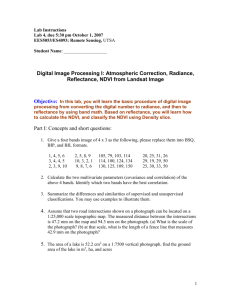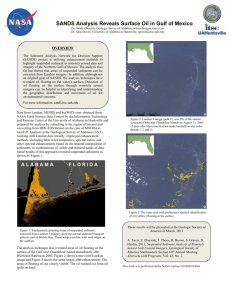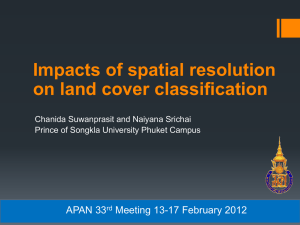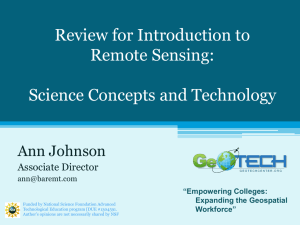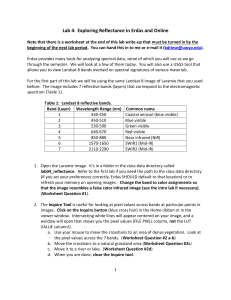DOC 192KB - Geoscience Australia
advertisement
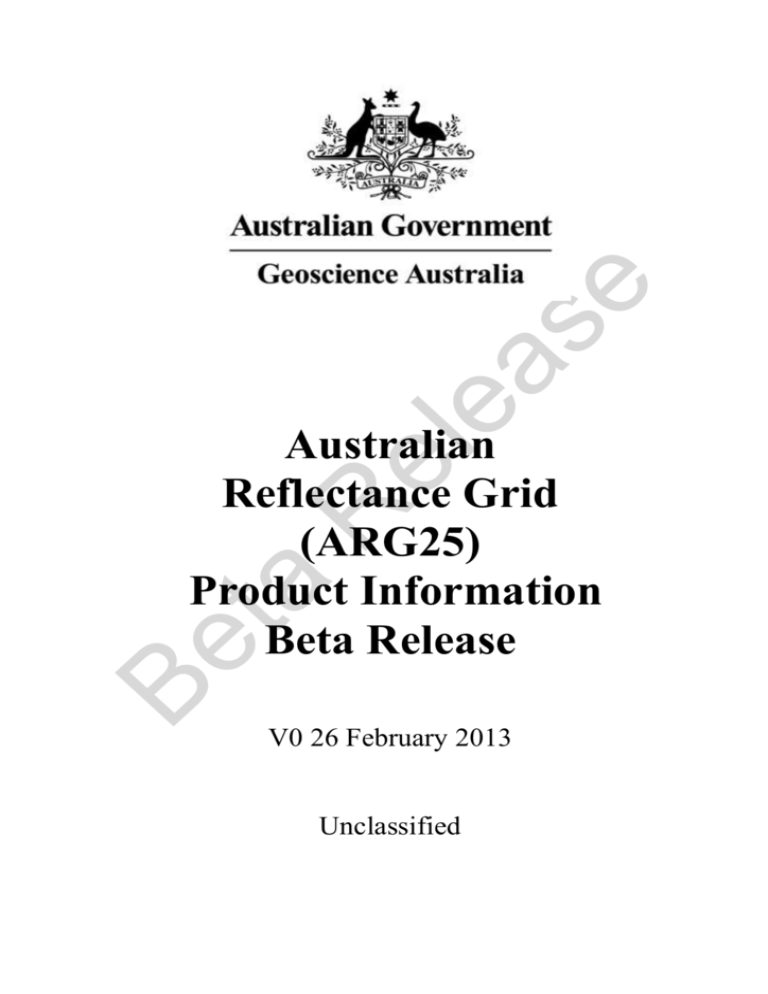
Australian Reflectance Grid (ARG25) Product Information Beta Release V0 26 February 2013 Unclassified ARG25 Product Information—Beta Release Page 2 of 23 26 Feb 2013 Geoscience Australia 26 Feb 2013 ARG25 Product Information—Beta Release Document History Sheet A.2 Revisions Revision Number 0 Date Nature of Change and Reason 26/02/2013 Minor edits Geoscience Australia Author/Approval Adam Lewis Page 3 of 23 ARG25 Product Information—Beta Release 26 Feb 2013 Table of Contents A Description ............................................................................................................. 5 Sheet A.1 Definition and Usage ....................................................................................... 5 Sheet A.2 Revisions ......................................................................................................... 3 Sheet A.3 Further Information ......................................................................................... 8 B Specification ........................................................................................................... 9 Sheet B.1 Provenance and Algorithms ............................................................................ 9 Sheet B.2 Technical Characteristics .............................................................................. 12 Sheet B.2.1 Relevant Platforms ........................................................................................12 Sheet B.2.2 Relevant Sensors ...........................................................................................13 Sheet B.2.3 Product Details ..............................................................................................15 C Availability .......................................................................................................... 17 Sheet C.1 Licencing and Access .................................................................................... 17 Sheet C.2 Delivery Information ..................................................................................... 18 Sheet C.3a Pixel Quality Flag ......................................................................................... 19 Sheet C.3b Pixel Quality Flag (examples) ...................................................................... 20 Glossary Page 4 of 23 .................................................................................................................. 21 Geoscience Australia 26 Feb 2013 A ARG25 Product Information—Beta Release Description Sheet A.1 Definition and Usage Product Name Australian Reflectance Grid 251 Abbreviation ARG25 Product Suite The Australian Reflectance Grid (ARG) is a suite of new generation EO products from GA. These standard data products deliver optical surface reflectance data across the Australian landmass and its coastal fringes. The resulting datasets are effectively sensor agnostic and future versions of products in this suite are intended to be readily comparable between scales. The first product in this suite is the ARG25, a medium resolution (25 m) grid based on Landsat imagery. A low resolution grid based on MODIS data is under development. Key Features of Product Suite The ARG product suite provides standardised optical surface reflectance datasets for Australia using robust physical models to correct for variations in image radiance values due to atmospheric properties, and sun and sensor geometry. These products also feature integrated pixel quality flags to indicate whether the reflectance values in each grid cell are deemed to be affected by band saturation, cloud or cloud shadow, or contain null values. It is the intention of GA that this suite of products will be available within a more general framework of nested grids. The grid cell sizes of products comprising this suite will be scalable to facilitate easy data comparison between different products. This format will greatly simplify comparison of image datasets acquired by different sensors at varying spatial scales. The resulting stack of surface reflectance grids are effectively consistent over space and time, and will be instrumental in identifying and quantifying environmental change. The ARG25 is the first ARG product to be released by GA. It is based on the Landsat TM/ETM+ archive and presents surface reflectance data in 25 m2 grid cells. Product Overview Radiance measurements from EO sensors do not directly quantify the surface reflectance of the Earth. Such measurements are modified by variations in atmospheric properties, sun position, sensor view angle, surface slope and surface aspect. To obtain consistent and comparable measures of Earth surface reflectance from EO, these variations need to be reduced or removed from the radiance measurements (Li et al., 2010). This is especially important when comparing imagery acquired in different seasons and geographic regions. The ARG25 product is created using a physics-based coupled BRDF and atmospheric correction model that can be applied to both flat and inclined surfaces (Li et al., 2012). The resulting surface reflectance values are comparable both within individual images and between images acquired at different times and/or with different sensors3. This product can be viewed as a data cube, with time as the third dimension. The surface reflectance data for each imaged date and time are stacked in chronological order, with Landsat TM/ETM+ sources being interleaved as appropriate to their acquisition time. Interrogation of this data cube allows the time series for individual grid cells, as well as their heritage and data quality, to be extracted and compared. 1 2 3 Formerly referred to as the Landsat Nadir BRDF-Adjusted Reflectance (NBAR) product. In ARG25-V0.1 and ARG25-V1.0+, grid cell size will be 0.00025º, which approximates 25 m for most of Australia. Notwithstanding differences due to variations in spectral bandwidth between sensors. Geoscience Australia Page 5 of 23 ARG25 Product Information—Beta Release 26 Feb 2013 Sheet A.1 Definition and Usage Product Background Geometric Presentation Current Radiance Corrections ARG25V0.0 Landsat TM/ETM+ archive from 2000 to 2010 Effects due to Image scenes resampled to atmospheric profile and custom UTM grids BRDF ARG25V0.1 Landsat TM/ETM+ archive from 2000 to 2010 Effects due to atmospheric profile and BRDF Geographic Grid derived from ARG25-V0.0 ARG25V1.0 Landsat TM/ETM+ archive plus Landsat OLI Effects due to atmospheric profile and BRDF Gridded values ARG25V2.0 Landsat TM/ETM+/MSS archive plus Landsat OLI Effects due to atmospheric profile, BRDF and topographic shading Gridded values Future Planned Product Versions Features Image Data Input Interim Version Landsat Archive GA has acquired Landsat TM/ETM+ imagery over Australia for several decades. While this data has been used extensively for numerous land and coastal mapping studies, its utility for accurate monitoring of environmental resources has been limited by the processing methods that have been traditionally used to correct for inherent geometric and radiometric distortions in EO imagery. To improve access to Australia’s archive of Landsat TM/ETM+ data, several collaborative projects have been undertaken in conjunction with industry, government and academic partners. These projects have enabled implementation of a more integrated approach to image data correction that incorporates normalising models to account for atmospheric effects, BRDF and topographic shading (Li et al., 2012). The approach has been applied to 11 years of Landsat TM/ETM+ imagery (2000–2010) to create the ARG25-V0.0 and ARG25-V0.1 products4. The advanced supercomputing facilities provided by the National Computational Infrastructure (NCI) at the Australian National University (ANU) have been instrumental in handling the considerable data volumes 5 and processing complexities involved with production of this product. It is intended that the Landsat archives from 1986 will be incrementally incorporated into the ARG25 product and released as subsequent versions. Surface Reflectance Correction Models Image radiance values recorded by passive EO sensors are a composite of: • surface reflectance; • atmospheric condition; • interaction between surface land cover, solar radiation and sensor view angle; and • land surface orientation relative to the imaging sensor. It has been traditionally assumed that Landsat imagery display negligible variation in sun and sensor view angles, however these can vary significantly both within and between scenes, especially in different seasons and geographic regions (Li et al., 2012). The ARG25 product delivers an estimate of surface reflectance from Landsat TM/ETM+ data using physical rather than empirical models. Accordingly, this product will ensure that reflective value differences between imagery acquired at different times by different sensors 6 will be primarily due to on-ground changes in biophysical parameters rather than artefacts of the imaging environment. Integrated Time Series Data Once consistent and comparable measures of surface reflectance have been retrieved from EO data, it is possible to quantify changes in Earth surface features through time. This process is further simplified when the surface reflectance data conforms to a sensor agnostic nested grid, 4 5 6 The ARG25-V0.0 and ARG25-V0.1 products do not include topographic shading correction nor the nested grid structure. 110,000 Landsat 5/7 scenes totalling ~140 TB. Notwithstanding differences due to variations in spectral bandwidth between sensors. Page 6 of 23 Geoscience Australia 26 Feb 2013 ARG25 Product Information—Beta Release Sheet A.1 Definition and Usage as envisaged for future versions of the ARG25 product. Given the growing time series of EO imagery, this landmark facility will streamline the process of reliably monitoring long-term changes in Australian land and water resources. Potential Applications ARG25 will significantly reduce pre-processing requirements for a wide range of land and coastal monitoring applications and render more accurate results from these analyses, particularly those utilising time series data. Such applications include various forms of change detection, including monitoring of urban growth, coastal habitats, mining activities, and agricultural production, as well as compliance surveys, scientific research and emergency management. Expected Lifespan Ongoing—while Medium Resolution Optical EO data stream is available for Australia. Geoscience Australia Page 7 of 23 ARG25 Product Information—Beta Release 26 Feb 2013 Sheet A.3 Further Information References Berk, A., Anderson, G.P., Acharya, P.K., Hoke, M.L., Chetwynd, J.H., Bernstein, L.S., Shettle, E.P., Matthew, M.W., and Adler-Golden, S.M. (2003) Modtran 4 Version 3 Revision 1 User's manual. Airforce Research Laboratory, Hanscom, MA, USA. Chander, G., Markham, B.L., and Helder, D.L. (2009) Summary of current radiometric calibration coefficients for Landsat MSS, TM, ETM+, and EO-1 ALI sensors. Remote Sensing of Environment 113, 893–903. Edberg, R., and Oliver, S. (2013) Projection-Independent Earth-Solar-Sensor Geometry for Surface Reflectance Correction. Submitted to IGARSS 2013, Melbourne. GA and CSIRO (2010) 1 second SRTM Derived Digital Elevation Models User Guide. Version 1.03. GA, Canberra. Forrest, R.B. (1981) Simulation of orbital image-sensor geometry, Photogrammetric Engineering and Remote Sensing 47, 1187-93. Irish, R. (2000) Landsat 7 Automatic Cloud Cover Assessment, sourced: http://landsathandbook.gsfc.nasa.gov/pdfs/ACCA_SPIE_paper.pdf, last accessed 12/11/2012. Irish, R.R., Barker, J.L., Goward, S.N., Arvidson, T. (2006) Characterization of the Landsat-7 ETM+ Automated Cloud –Cover Assessment (ACCA) Algorithm. Photogrammetric Engineering & Remote Sensing 72 (10), 1179-88. Kalnay, E. Kanamitsu, M., Kistler, R., Collins, W., Deaven, D., Gandin, L., Iredell, M., Saha, S., White, G., Woollen, J., Zhu, Y., Chelliah, M., Ebisuzaki, W., Higgins, W., Janowiak, J., Mo, K.C., Ropelewski, C., Wang, J., Leetmaa, A., Reynolds, R. Jenne, R., Joseph, D. (1996) The NCEP/NCAR 40-Year Reanalysis Project. Bulletin of the American Meteorological Society 77, 437-71. Li, F., Jupp, D.L.B., Reddy, S., Lymburner, L., Mueller, N., Tan, P., and Islam, A. (2010) An Evaluation of the Use of Atmospheric and BRDF Correction to Standardize Landsat Data. IEEE J. Selected Topics in Applied Earth Observations and Remote Sensing 3, 257–70. Li, F., Jupp, D.L.B., Thankappan, M., Lymburner, L., Mueller, N., Lewis, A., and Held, A. (2012) A physics-based atmospheric and BRDF correction for Landsat data over mountainous terrain. Remote Sensing of Environment 124, 756–70. Li, F. (2010) ARG25 Algorithm Theoretical Basis Document. GA, Canberra. Lubke, M. (2012) Landsat Geometry Calibration/Validation Update. Presentation at LTWG #21, 25 September 2012, Sioux Falls. USGS, USA. OGC (2006) OpenGIS® Web Map Server Implementation Specification (Ed: Jeff de la Beaujardiere) Ref. OGC® 06–042. OGC OGC (2010) OGC® WCS 2.0 Interface Standard – Core. (Ed: Peter Baumann) Ref. OGC 09–110r3. OGC. OGC (2013) CF-netCDF3 Data Model Extension Standard (Eds: Ben Domenico and Stefano Nativi) Ref. OGC 11-165r2. OGC. Strahler, A.H., and Muller, J.-P. (1999) MODIS BRDF/Albedo Product: Algorithm Theoretical Basis Document Version 5.0. http://modis.gsfc.nasa.gov/data/atbd/atbd_mod09.pdf TM World Borders vector file: http://thematicmapping.org/downloads/world_borders.php USGS (2012a) Landsat Thematic Mapper (TM) Level 1 (L1) Data Format Control Book (DFCB) LS-DFCB-20 Version 4.0.. http://landsat.usgs.gov/documents/LS-DFCB-20.pdf USGS (2012b) Landsat 7 (L7) Enhanced Thematic Mapper Plus (ETM+) Level 1 (L1) Data Format Control Book (DFCB). LS-DFCB-04 Version 15.0. http://landsat.usgs.gov/documents/LS-DFCB-04.pdf Lubke, M. (2012) Landsat Geometry Calibration/Validation Update. Presentation at LTWG #21, 25 September 2012, Sioux Falls, USA. Vincenty, T. (1975) Direct and Inverse Solutions of Geodesies on the Ellipsoid with Application of Nested Equations. Survey Review 23, 88–93. Zhu, Z. and Woodcock, C. E. (2012) Object-based cloud and cloud shadow detection in Landsat imagery. Remote Sensing of Environment 118, 83–94. Websites Page 8 of 23 http://www.ga.gov.au/earth-observation/accessing-satellite-imagery/future-of-landsat-archive.html landsathandbook.gsfc.nasa.gov Geoscience Australia 26 Feb 2013 B ARG25 Product Information—Beta Release Specification Sheet B.1 Provenance and Algorithms Primary Landsat TM (Landsat-5) Level 1 Systematic Terrain Correction Imagery Landsat ETM+ (Landsat-7) Level 1 Systematic Terrain Correction Imagery Landsat 5/7 Satellite Ephemeris data7 Maximum view angle (degrees) 8 Acquisition day and time (in UTC) to compute sun position Metadata Size (number of pixels and lines) TM/ETM+ Image scene Cell Size8 NW location Centre location Source Data Sources Ancillary Derived Data Earth rotational angular velocity 0.000072722052 radians/second Earth-sun distance LUT Distance from image scene centre to the sun Spectal filter Sensor Response Function Solar irradiance LUT Sun position at image date/time MODIS BRDF Shape Function9 BRDF parameters for imagery acquired during MODIS era BRDF database derived from 2001–2011 MODIS archive10 BRDF parameters for imagery acquired before MODIS era DSM/DEM data from 1-second SRTM11 Height at image scene centre, plus slope and aspect per pixel for topographic correction Aerosol optical depth12 Monthly ozone image13 Total water vapour for image date/time14 Atmospheric state in whole profile for Modtran 5 Radiative Transfer Model CO2 concentration for image date/time15 Modtran Seasons for atmospheric profiles 7 8 9 10 11 12 13 14 15 Tropical Summer: latitude < 23S Mid-Latitude Summer: 23S < latitude < 50S Based on NORAD daily Two Line Element (TLE) for Landsat 5/7 (http://landsat.usgs.gov/science_DEoption1.php) then adjusted to match image scene centre from scene metadata and used to compute orbital parameters (semi-major axis, eccentricity and angular velocity). See Table B.2.3 for numeric value. Based on Ross-Li model—see Strahler and Muller (1999). Under development. GA and CSIRO (2010)—http:/www.ga.gov.au/image_cache/GA18067.pdf. Ideally derived from same day AATSR data; else monthly composite AATSR data; else long term monthly average aerosol data. Aerosol optical depth at 550nm is used to compute visibility (Berk et al., 2003). Monthly average based on Canadian Ozone Map (http://exp-studies.tor.ec.gc.ca/cgi- bin/selectMap). Ideally the WMO radiosonde network would be used but this does not offer continental coverage for Australia, so the Total Precipitable Water Content product (NOAA NCEP; Kalnay et al., 1996) is used. Set as constant=375 ppmv. Geoscience Australia Page 9 of 23 ARG25 Product Information—Beta Release 26 Feb 2013 Sheet B.1 Provenance and Algorithms Major Algorithms ARG2516 uses a combined atmospheric, BRDF and topographic shading correction model based on physical parameters to extract surface reflectance values from Landsat TM/ETM+ as reported in Li et al. (2010) and Li et al. (2012). For more details, see the Algorithm Theoretical Basis Document (Li, 2010). Processing Sequence ARG25-V0.0, ARG25-V0.1 and ARG25-V1.0 (atmospheric and BRDF correction only): 1. Extract metadata from data sources. 2. Calculate sun and sensor angles for each pixel in image scene using satellite ephermis data and a sampling-gridding procedure based on a geodesic path located with Vincenty’s algorithm (Vincenty, 1975; Edberg and Oliver, 2013)17. 3. Determine values for six base atmosphere parameters 18 across each image scene: a. divide scene into quarters and select the nine unique points which form the corners of these quadrants; b. compute the six parameters across optical spectrum at each of the nine points using Radiative Transfer Model (Modtran 5) and atmospheric state data; c. accumulate values for the six parameters at each of the nine points to correspond to Landsat TM/ETM+ bands using Landsat spectral response function; and d. interpolate accumulated values for the six parameters across image scene using bilinear method. 4. Use interpolated, accumulated values for the six base atmosphere parameters 12 to compute the atmospheric and BRDF correction for each pixel and output the normalised surface reflectance for sun angle of 45. ARG25-V2.0+ (correction for atmospheric, BRDF and topographic shading effects): 1. Extract metadata from data sources. 2. Pre-process Digital Surface Model (DSM) using modal filter and resample to match image grid. 3. For each pixel in image scene, calculate: a. sun and sensor angles using satellite ephermis data and a sampling-gridding procedure based on a geodesic path located with Vincenty’s algorithm (Vincenty, 1975; Edberg and Oliver, 2013)18; b. slope, aspect, incident, exiting and their azimuth angles on sloping surface; and c. cast shadow given sun and satellite directions. 4. Determine values for six base atmosphere parameters19 across each image scene: a. divide scene into quarters and select the nine unique points which form the corners of these quadrants; b. compute six parameters across optical spectrum at each of the nine points using Radiative Transfer Model (Modtran 5) and atmospheric state data; c. accumulate values for six parameters at each of the nine points to correspond to Landsat TM/ETM+ bands using Landsat spectral response function; and d. interpolate accumulated values for six parameters across image scene using bilinear method. 5. Compute atmospheric, BRDF and topographic shading corrected surface reflectance, normalised for sun angle of 45. 16 17 18 The ARG25-V0.0 and ARG25-V0.1 products do not include topographic shading correction nor the nested grid structure. View angle calculations are based on method of Forrest (1981). Tv—Total transmittance in view direction; Ts—Total transmittance in sun direction; fv—Fraction of diffuse radiation if sun were in view direction; fs—Fraction of diffuse radiation if sun were in sun direction; S—Reflectance of atmosphere from ground; and 0—Reflectance of atmosphere from satellite. Page 10 of 23 Geoscience Australia 26 Feb 2013 ARG25 Product Information—Beta Release Sheet B.1 Provenance and Algorithms Validation of Underlying Algorithms Accuracy and Limitations Atmospheric and BRDF Correction As detailed in Li et al. (2010), the atmospheric and BRDF correction algorithm was validated in three parts: 1. Validate combined atmospheric and surface BRDF correction using field reflectance measurements at two very different sites, Gwydir, NSW, and Lake Frome, SA—correlation (measured as r) between corrected image values and field data was > 0.95; 2. Validate surface BRDF correction using data from image overlap areas of adjacent paths acquired one week apart in northeast Queensland—normalised reflectance factor was very close in corrected images, but not in original images, and difference in reflectance factor values between corrected and uncorrected images can be > 0.05; and 3. Cross-validate Landsat TM data for accuracy of spectral reflectance using the MODIS reflectance product for Lake Frome—correlation (measured as r2) between corrected Landsat TM image values and MODIS reflectance product was 0.93–0.97 in all bands except Landsat TM band 5, which was 0.90. The results clearly show that the algorithm can remove most of the BRDF effect without empirical adjustment and that cross-calibration between the Landsat ETM+ and MODIS sensors is achievable. Topographic Correction As detailed in Li et al. (2012), two high relief areas in southeast Australia (Australian Alps in northeast Victoria and the Blue Mountains in NSW) were used to test the algorithm against eight Landsat images with varying solar angles (seasons), and terrain types. Visual assessment showed that the algorithm removed much of the topographic effect and detected deep shadows in all eight images. An indirect validation based on the change in correlation between the data and terrain slope showed that the correlation coefficient between the surface reflectance factor and the cosine of the incident (sun) angle reduced dramatically after the topographic correction algorithm was applied. The correlation coefficient typically reduced from 0.80–0.70 to 0.05 in areas of significant relief. It was also shown how the corrected surface reflectance can provide suitable input data for multi-temporal land cover classification in areas of high relief based on spectral signatures and spectral albedo, while the products based only on BRDF and atmospheric correction cannot. To provide comparison with previous work and to validate the proposed algorithm, two empirical methods based on the C-correction were used as well as the established SCS-method to provide benchmarks. The proposed method was found to achieve the same measures of shade reduction without empirical regression. 1. Atmospheric correction accuracy is dependent on the quality of aerosol data available to determine the atmospheric profile at time of image acquisition. 2. BRDF correction is based on low resolution imagery (MODIS) which is assumed to be relevant to medium resolution imagery such as Landsat TM/ETM+. BRDF correction is applied to each whole Landsat TM/ETM+ scenes and does not account for changes in land cover. It also excludes effects due to topographic shading and local BRDF. This algorithm is dependent on the availability of relevant MODIS BRDF data. 3. Topographic shading correction algorithm is designed for medium resolution imagery and assumes that hill slopes are resolved by the sensor system (Li et al., 2012). The algorithm assumes that: a. BRDF effect for inclined surfaces is modelled by the surface slope and does not account for land cover orientation relative to gravity (as occurs for some broad leaf vegetation with vertical leaf orientation). Geoscience Australia Page 11 of 23 ARG25 Product Information—Beta Release 26 Feb 2013 Sheet B.2 Technical Characteristics Sheet B.2.1 Relevant Platforms Full Name Landsat-5 Landsat-7 Abbreviation Landsat-5 Landsat-7 Agency NASA (USA) (launch and satellite maintenance) USGS (USA) (ground stations and data handling) Heritage Landsat-1 launched in 1972; Landsat-7 last in series; Landsat Data Continuity Mission (LDCM) due for launch in 2013 Application Areas Land and Coastal Mapping Land and Coastal Mapping; hydrology Launch Date 1 March 1984 15 April 1999 End of Life 18 November 2011 N/A Orbit Type Sun-synchronous, near polar Direction Ascending Altitude 705 Km Inclination 98.2º Period 99 minutes (~14.5 orbits/day) Repeat Cycle 16 days (233 orbits/year) Equatorial Crossing Time 0945 (± 15 minutes) LST 1000 (± 15 minutes) LST Multi-Spectral Scanner (MSS) Enhanced Thematic Mapper Plus (ETM+) Sensors Page 12 of 23 Thematic Mapper (TM) Geoscience Australia 26 Feb 2013 ARG25 Product Information—Beta Release Sheet B.2 Technical Characteristics (continued) Sheet B.2.2 Relevant Sensors Full Name (Landsat) Thematic Mapper (Landsat) Enhanced Thematic Mapper Plus Abbreviation (Landsat) TM Landsat ETM+ Platform Landsat-4 and -5 satellites Landsat-7 satellite Heritage MSS sensors carried on board Landsat-1 and -5 Enhanced version of TM sensors carried on board Landsat-4 and -5 Operational No Yes; Scan Line Correction (SLC) fault since May 2003 GA Data Reception September 1987–31 December 1999; 1 July 2003–18 November 2011 July 1999–present; small gaps from 31 May 2003 due to SLC fault Sensing Mode Passive Passive Scanning Method Opto-mechanical Opto-mechanical and Thermal Infrared Application Areas Land and coastal mapping Land and coastal mapping, hydrology Spectral Bands Band Spectral Range (m) 1 0.45– 0.52 EM Region Visible Blue Band Spectral Range (m) 1 0.45– 0.52 Visible Blue 2 0.52–0.60 Visible Green 2 0.52–0.60 Visible Green 3 0.63–0.69 Visible Red 3 0.63–0.69 Visible Red 4 0.76–0.90 Near Infrared 4 0.76–0.90 Near Infrared 5 1.55–1.75 Middle Infrared 5 1.55–1.75 Middle Infrared 6 10.40– 12.50 7 2.08–2.35 Middle Infrared 8 0.52–0.90 Panchromatic 6 7 10.40– 12.50 Thermal Infrared 2.08–2.35 Middle Infrared Radiometric Quantisation 8 bit (256 levels) Radiometric Quality Radiometric Calibration Uncertainty ± 5%19 19 EM Region Thermal Infrared Best 8 of 9 bits Chander et al. (2009)—early years of Landsat 5 were less reliable. See also http://landsathandbook.gsfc.nasa.gov/sysper/ Geoscience Australia Page 13 of 23 ARG25 Product Information—Beta Release 26 Feb 2013 Sheet B.2 Technical Characteristics (continued) Sheet B.2.2 Relevant Sensors Swath Width 185 Km Ground Sampling Interval (GSI or pixel size) Maximum view angle Geometric Quality 20 Band Metres Band Metres 1-5 and 7 30 1-5 and 7 30 6 120 60 8 15 (theoretical), 18 (actual) 23.5 Absolute Error < 1 pixel Absolute Error < 1 pixel Relative Error < 1 pixel Relative Error < 1 pixel Band-to-Band Error < 0.31 pixel Band-to-Band Error < 0.17 pixel Repeat Coverage Interval Once per repeat cycle of satellite platform Stereo base-height ratio N/A Pointing angle Vertical only 20 6 Based on Lubke (2012). Page 14 of 23 Geoscience Australia 26 Feb 2013 ARG25 Product Information—Beta Release Sheet B.2 Technical Characteristics (continued) Sheet B.2.3 Product Details Frequency Based on available Landsat TM/ETM+ imagery Temporal Extent January 2000 to December 2010 Geographic Coverage Spatial Extent21 Grid Dimensions NW 10S latitude, 108E longitude NE 45S latitude, 108E longitude SW 10S latitude, 155E longitude SE 45S latitude, 155E longitude W–E 188,000 grid cells N–S 140,000 grid cells ITRF Epoch GDA94 Datum GRS80 Ellipsoid Mapping Base for ARG25-V0.0 Image Grid for ARG25-V0.0 Mapping Base for ARG25-V0.1 Image Grid for ARG25-V0.1 Grid Bit Depth 6,378,137 m Inverse Flattening (1/f) 298.25722210088 Eccentricity (e2) 0.0066943800229034 Map Co-ordinate System MGA94 Projection Universal Transverse Mercator (UTM) Origin Centre of UTM zone Cell Size 25 m Type Custom Grid Specification USGS (2012a, 2012b) Pixel Origin Top Left Orientation North Upwards Resampling Method Cubic Convolution Datum WGS84 (EPSG 4326) Projection Geographic Cell Size 0.00025º Type Geographic Grid Pixel Origin Top Left Orientation North Upwards Resampling Method Nearest Neighbour from ARG25-V0.0 2 byte integer (16 bits) Data Spectral Bands Quicklook 21 Semi-major axis (a) Band 1 Surface Reflectance from Landsat TM/ETM+ bands 1 Band 2 Surface Reflectance from Landsat TM/ETM+ bands 2 Band 3 Surface Reflectance from Landsat TM/ETM+ bands 3 Band 4 Surface Reflectance from Landsat TM/ETM+ bands 4 Band 5 Surface Reflectance from Landsat TM/ETM+ bands 5 Band 6 Surface Reflectance from Landsat TM/ETM+ bands 7 Band 7 Pixel Quality Flag (see Sheet C.3) Red Landsat TM/ETM+ band 7 Green Landsat TM/ETM+ band 4 Blue Landsat TM/ETM+ band 1 For full Australian coverage. Geoscience Australia Page 15 of 23 ARG25 Product Information—Beta Release 26 Feb 2013 Sheet B.2 Technical Characteristics (continued) Sheet B.2.3 Product Details Data Range Solar Zenith Angle Surface Reflectance 1 to 10,000 Pixel Quality Flag* Bit map of 16 binary tests (see Sheet C.3) 45 * Pixel quality flag not available in beta release of this product. Page 16 of 23 Geoscience Australia 26 Feb 2013 C ARG25 Product Information—Beta Release Availability Sheet C.1 Licencing and Access Support Supported Licencing Creative Commons 3.0 By Attribution Search Tool http://www.ga.gov.au/earth-observation/arg25.html Preview Facility Web Map Service 1.3.0 (WMS; OGC, 2006) for Quicklook Image Web Coverage Service 2.0 (WCS; OGC, 2010) for all bands Ordering and Distribution n/a Geoscience Australia Page 17 of 23 ARG25 Product Information—Beta Release 26 Feb 2013 Sheet C.2 Delivery Information nnn_nnn_fff_ggg_hhh_ppp_rrr_yyyymmdd_x where: nnn_nnn: satellite and sensor ID fff: product code ggg: process code hhh: process source/group ppp: path rrr: row yyyymmdd: acquisition date x: version number File Name Example file name: LS5_TM_NBAR_P54_GANBAR01-002_090_081_20090407_1 where LS5—Landsat 5 (satellite ID) TM—Thematic Mapper scene (sensor ID) NBAR—Nadir BRDF Adjusted Reflectance (product code) P54—Ortho NBAR product (process code) GANBAR01—GA product code 002—Acquisition Ground Station ID (Alice Springs) Path—090 Row—081 Acquistion Date—07/04/2009 Version Number—1 ARG25-V0.0 ARG25-V0.1 Data GeoTIFF (7 bands) GeoTIFF (7 bands) NetCDF3/4 (OGC, 2013; Unidata, 2012) Metadata XML XML Quicklook JPEG (3 bands) Web Services (including WMS 1.3.0 and WCS 2.0) File Format Data Volume Page 18 of 23 Surface Reflectance Pixel Quality Surface Reflectance Pixel Quality Per Year 10 Tb 2.4 Tb tbd tbd Per Grid Block tbd tbd tbd tbd Total Product 110 Tb 26 Tb tbd tbd Geoscience Australia 26 Feb 2013 ARG25 Product Information—Beta Release Sheet C.3a Pixel Quality Flag Test Condition Bit Position (right to left) Pixel Quality Flag Equals 0 if this pixel is Pixel Quality Flag Equals 1 if this pixel is Band 1 is saturated 0 Saturated in Band 1 Not saturated in Band 1 Band 2 is saturated 1 Saturated in Band 2 Not saturated in Band 2 Band 3 is saturated 2 Saturated in Band 3 Not saturated in Band 3 Band 4 is saturated 3 Saturated in Band 4 Not saturated in Band 4 Band 5 is saturated 4 Saturated in Band 5 Not saturated in Band 5 Band 6-122 is saturated 5 Saturated in Band 6-1 Not saturated in Band 6-1 Band 6-222 is saturated 6 Saturated in Band 6-2 Not saturated in Band 6-2 Band 7 is saturated 7 Saturated in Band 7 Not saturated in Band 7 Contiguity 8 Null value in at least one band All bands for this pixel contain non-null values Land or Sea23 9 Sea Land Cloud (ACCA)24 10 Cloud No Cloud (Fmask)25 Cloud 22 23 24 25 26 27 28 29 11 Cloud No Cloud Cloud Shadow (ACCA)26 12 Cloud Shadow No Cloud Shadow Cloud Shadow (Fmask)27 13 Cloud Shadow No Cloud Shadow Topographic Shadow28 14 Topographic Shadow No Topographic Shadow To be determined29 15 N/A N/A This is designed to match Landsat 7 ETM+. The thermal band for Landsat 5 TM corresponds to Band 6-1 and this value is duplicated in Band 6-2. Land and sea masking is based on vector data from TM World Borders (http://thematicmapping.org/downloads/world_borders.php) spliced with Australian Coastal Boundary using a 100m buffer into the sea. Automatic Cloud Cover Assessment (ACCA) algorithm described in Irish (2000) and Irish et al., (2006). Function of Mask (Fmask) uses TOAR rather than NBAR as input reflectance (http://www.sciencedirect.com/science/article/pii/S0034425711003853). Only computed for cloud detected by ACCA algorithm using in-house algorithm. Only computed for cloud detected by Fmask algorithm using in-house algorithm. This feature has not been implemented yet so bit 14 is set to value 0. Default untested value currently set to 0. Geoscience Australia Page 19 of 23 ARG25 Product Information—Beta Release 26 Feb 2013 Sheet C.3b Pixel Quality Flag (examples) Binary Code (for bits 0 to 15) 15 14 13 12 11 10 9 0 0 0 0 1 0 1 0 0 1 0 1 1 1 8 1 1 7 1 1 6 1 1 5 1 1 4 0 1 3 1 1 2 1 1 1 1 1 0 0 1 Equivalen t Decimal value Code Interpretation 13294 Bands 1 and 5 are saturated (bits 0 and 4 = 0) No null values (bit 8 = 1) Land pixel (bit 9 = 1) Clouds detected by ACCA and Fmask (bits 10 and 11 = 0) No cloud shadow (bits 12 and 13 = 1) 4095 No saturated bands (bits 0–7=1) No null values (bit 8 = 1) Land pixel (bit 9 = 1) No cloud detected (bits 10 and 11 = 1) Cloud shadow detected by ACCA and Fmask (bits 12 and 13 = 0) 0 0 1 1 0 0 1 1 0 1 1 0 1 1 1 0 13166 Bands 1, 5 and 7 are saturated (bits 0, 4 and 7 = 0) No null values (bit 8 = 1) Land pixel (bit 9 = 1) Clouds detected by ACCA and Fmask (bits 10 and 11 = 0) No cloud shadow (bits 12 and 13 = 1) 0 0 1 1 1 1 1 1 1 1 1 1 1 1 1 1 16383 Clear Land Pixel— no saturation, null values, cloud, or cloud shadow Page 20 of 23 Geoscience Australia 26 Feb 2013 ARG25 Product Information—Beta Release Glossary AATSR ACCA ALOS AMG ANZLIC ANU ARG ARG25 ARG25PI Aqua ASCII ASTER ATBD AVHRR AVNIR-2 BIL BSQ BoM BRDF CalVal CCBY CF CRCSI Advanced Along-Track Scanning Radiometer Automatic Cloud Cover Assessment (Irish et al., 2006) Advanced Land Observing Satellite (JAXA, Japan) Australian Map Grid Australian and New Zealand Land Information Council Australian National University Australian Reflectance Grid Australian Reflectance Grid 25 ARG25 Product Information NASA satellite collecting data on Earth's water cycle (USA) American Standard Code for Information Interchange Advanced Space-borne Thermal Emission and Reflection Radiometer Algorithm Theoretical Basis Document Advanced Very High Resolution Radiometer (NOAA) Advance Visible and Near Infrared Radiometer type 2 Band Interleaved with Line Band Sequential Bureau of Meteorology (Australia) Bidirectional Reflectance Distribution Function Calibration and Validation of EO data Creative Commons By Attribution Climate and Forecast metadata (for NetCDF) Cooperative Research Centre for Spatial Information Commonwealth Scientific and Industrial Research Organisation CSIRO (Australia) DEM Digital Elevation Model DSM Digital Surface Model ECW ER Mapper Enhanced Compressed Wavelet EO Earth Observation EOS Earth Observing System (NASA) EPSG European Petroleum Survey Group ER Mapper ERDAS Image Processing System ERS ER Mapper ASCII format for extended metadata in raster header files ESA European Space Agency ETM+ Enhanced Thematic Mapper Plus sensor on board Landsat-7 Fmask Function of Mask algorithm (see Sheet B.4) GA Geoscience Australia GB Gigabyte (106 KB) Geoscience Australia Page 21 of 23 ARG25 Product Information—Beta Release 26 Feb 2013 GeoTIFF GSI IRS-P6 ITRF JAXA KB TIFF with geo-referencing Ground Sampling Interval Indian Remote Sensing satellite, also known as RESOURCESAT-1 International Terrestrial Reference Frame Japan Aerospace Exploration Agency Kilobyte (210 bytes) WA Statutory Authority responsible for Land Information and Landgate Geographic Data (Australia) Originally known as the Earth Resource Technology Satellite, renamed in Landsat 1975 (USA) LDCM Landsat Data Continuity Mission (USA) LUT Look-Up Table MB Megabyte (103 KB) MGA Map Grid of Australia MODIS MODerate-Resolution Imaging Spectroradiometer (NASA) Modtran Atmospheric radiative transfer model MSS Multispectral Scanner NASA National Aeronautics and Space Administration (USA) NaviGAtor GA data archive and access facility NBAR Nadir BRDF-Adjusted Reflectance NCEP National Centres for Environmental Prediction (NOAA, USA) NCI National Computational Infrastructure (at ANU) National Earth Observation group within Geoscience Australia (formerly NEO the Australian Centre for Remote Sensing, ACRES) NetCDF Network Common Data Form NNG National Nested Grid (ANZLIC, 2012) NOAA National Oceanic and Atmospheric Administration (USA) NORAD North American Aerospace Defence Command (USA) NPP National Polar-orbiting Partnership (USA) OGRE Optical, Geospatial, Radar and Elevation Supplies and Services Panel PALSAR Phased Array type L-band Synthetic Aperture Radar PRISM Panchromatic Remote-sensing Instrument for Stereo Mapping RADAR RAdio Detection And Ranging Radarsat Pair of satellites providing C-band radar data (Canada) SAR Synthetic Aperture Radar SLC Scan Line Corrector SRTM Shuttle RADAR Topography Mission (USA) SUOMI Satellite mission replacing EOS satellites (NASA) NPP TOAR Top Of Atmosphere Reflectance TB Terabyte (109 KB) Page 22 of 23 Geoscience Australia 26 Feb 2013 Terra TIFF TLE TM TOAR USGS UTC UTM VIIRS VPAC WCS WGS WMO WMS XML ARG25 Product Information—Beta Release NASA satellite collecting data on Earth's land processes (USA) Tagged Image File Format Two Line Element Thematic Mapper Top Of Atmosphere Reflectance United States Geological Survey (USA) Universal Time Coordinated Universal Transverse Mercator Visible Infrared Imaging Radiometer Suite Victorian Partnership for Advanced Computing Web Coverage Service World Geodetic System World Meteorological Organisation (UN) Web Map Service Extensible Mark-up Language Geoscience Australia Page 23 of 23

